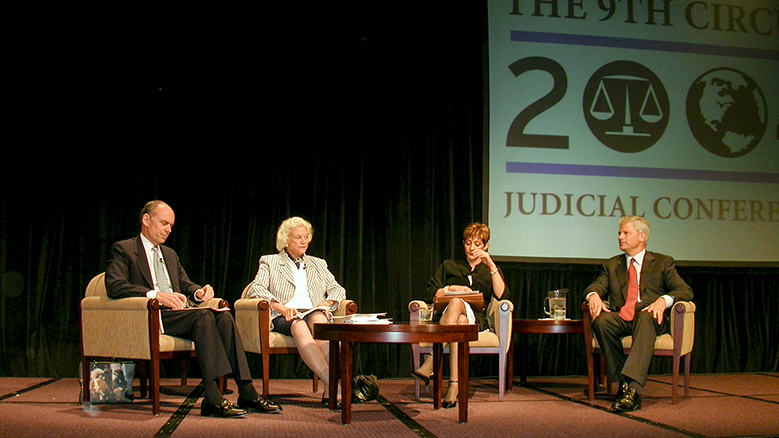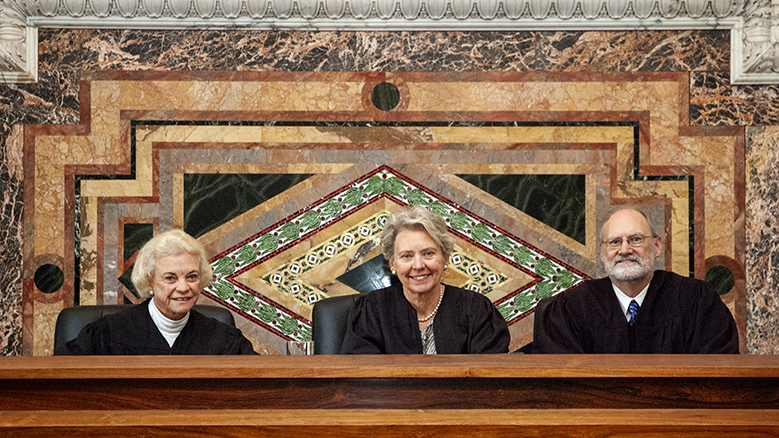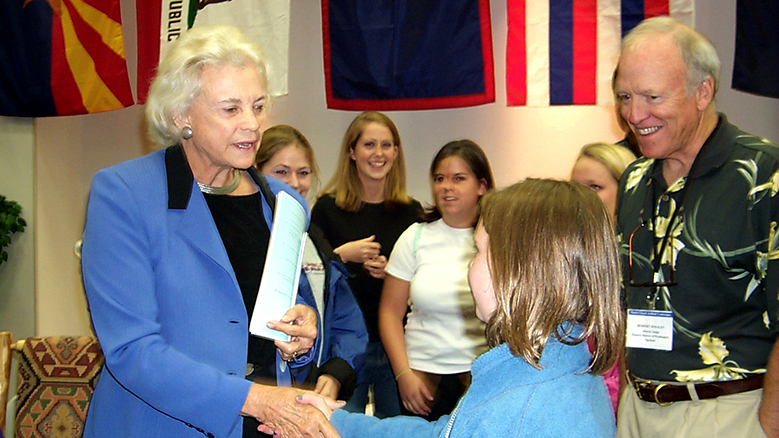
|
Ninth Circuit Judges Reflect on the Passing of Retired Associate Justice Sandra Day O'ConnorDec. 6, 2023
Associate Justice Sandra Day O’Connor (Ret.), of the U.S. Supreme Court, died December 1 in Phoenix at the age of 93. Justice O’Connor was the first woman appointed to the Supreme Court. Appointed in 1981 by President Ronald Reagan, she retired in 2006 after serving more than 24 years on the Court. Justice O’Connor has a long history with the Ninth Circuit, which includes Arizona. As the Ninth Circuit’s justice, she came to the circuit’s annual judicial conferences and participated in the traditional Conversation with the Justice session held each year. Her last Ninth Circuit conference was in Spokane, Washington, in 2005, shortly after announcing her retirement. In post-retirement appearances, Justice O’Connor sat, by designation, with the U.S. Court of Appeals for the Ninth Circuit, serving on three-judge panels, hearing oral arguments in a variety of courts up until 2013. In 2001, the Sandra Day O’Connor U.S. Courthouse was completed in Phoenix—the seat of the U.S. District of Arizona. The nine-foot-tall bronze statue of Justice O’Connor was unveiled in September 2002, when judges, lawmakers, civic leaders, members of the bar and 200 elementary school children witnessed the ceremony. In her 2005 appearance at the Ninth Circuit’s Judicial Conference, Justice O’Connor told how, unable to get hired because she was a woman, she wrote a long letter to the district attorney of San Mateo County, California, offering to work for free and ended up sharing space in a secretary's office. She reflected on her long career: “It’s been such a privilege to work on the court,” she said, “to be one of the nine voices. That was a long time to be together,” she said. “Sometimes the dissents get pretty vigorous. I don’t always like that, but on the other hand, I occasionally resort to a little vigor of my own.” In an October 2018 letter Justice O’Connor spoke of her commitment to civics education. “I feel so strongly about the topic because I’ve seen first-hand how vital it is for all citizens to understand our Constitution and unique system of government and participate actively in their communities.” She started iCivics with a vision "to teach the core principles of civics to middle and high school students with free online interactive games and curriculum that make learning relevant and remarkably effective. Today, iCivics (www.icivics.org) reaches half the youth in our country.” Justice O’Connor touched the lives of many still serving in the Ninth Circuit. “Justice O’Connor was a gracious mentor and guide to me,” said Circuit Judge Sandra S. Ikuta, who clerked for Justice O’Connor from 1989 to 1990. “I had no idea, until I had law clerks of my own, how much energy Justice O’Connor expended in taking care of her clerks. Even while she was being treated for breast cancer, she had the time, energy, and desire to enrich her clerks’ experience, taking us on field trips to the Tidal Basin, the Hollyhock House, and Camp Hoover, and of course instigating a farewell skit about our term on the Court. When I left her chambers to become a lawyer and then a judge, she still graciously kept in touch and never forgot to ask about my family whose names and interests she always remembered. “I had the honor of sitting with her when she was sitting by designation on the Ninth Circuit in Arizona, in October 2009,” said Judge Ikuta. “She showed the same meticulous attention to detail and penetrating questions as she had at the Court. But she also made time to travel with me from Phoenix to Tucson (where we had a second sitting) so she could talk to me about my life and career. Justice O’Connor will always be remembered as the outstanding trailblazer she was, but to me she was also a friend.” Ninth Circuit Judge Michelle T. Friedland clerked for Justice O’Connor from 2001 to 2002. “We all lost a national treasure with Justice O’Connor’s passing, and I personally lost my closest mentor,” Judge Friedland said. “Justice O’Connor forged the path that my life has followed. Seeing her join the Supreme Court made me feel as a fourth-grade girl that I could aspire to anything. I had the great privilege of clerking for Justice O’Connor and learned many lessons from her that I think about every day—to think always about the effect of our decisions on real people, to treat everyone with dignity, and to disagree respectfully. “In addition to being the wisest of jurists, Justice O’Connor taught her clerks how to live a balanced life, including us in everything from her morning aerobics in the Supreme Court gym to field trips to monuments, art exhibits, and sporting events. And she was a dedicated mentor. Even after her health started declining, she attended the Senate hearing on my judicial nomination and came to the Ninth Circuit to swear me in once I was confirmed. “Justice O’Connor promoted civics education everywhere she went, talking to every classroom and community group about the importance of the rule of law and personal engagement in our democracy. I would not be where I am today if not for her, and words cannot capture how grateful I am to her and how much I will miss her,” Judge Friedland said. “In 1981 Sandra Day O’Connor was catapulted from the second highest state court in Arizona to the highest court in the land,” said Senior Circuit Judge Mary M. Schroeder. “Folks were surprised, but Sandra had a brilliant mind, had experience in all three branches of state government and was thus a quick study. She carried herself with such dignity and grace that she became the role model for young women and girls everywhere. She was the first woman to serve as the Circuit Justice for the 9th Circuit and she and I were the first all-woman team of circuit justice and circuit chief judge, something we were both proud of. She faithfully attended our circuit conferences and let us know when we needed improvement.” Chief Judge of the Ninth Circuit Mary H. Murguia said “I vividly recall the morning in August of 1981 when President Reagan nominated Sandra Day O’Connor to the Supreme Court. I listened intently to the announcement while getting ready for my summer job as a docket clerk in the criminal division of my local courthouse, awestruck by the breakthrough. At last, the highest court was open to women in the legal profession. This was a watershed moment for women of my generation. Justice O’Connor’s remarkable life and career paved the way for me, and so many others, to see ourselves in leading roles, and to aspire to serve on the federal bench. Her pragmatic, discerning, gracious and consensus-building tenure on the Court is a model for our times, and her legacy is a gift to our country and to the world. I will always be grateful for her service and feel indebted to her.” Senior Circuit Judge Sidney R. Thomas said “Justice O’Connor was one of the most graceful persons I’ve ever met. In addition to working with her as our Circuit Justice, I had the privilege of hearing cases with her in San Francisco and Montana. She was unfailingly kind to everyone involved and made everyone in the room feel special. She was a true Westerner, having grown up on the Lazy B Ranch in Arizona, and understood the unique challenges of the West. She was a great friend, and we will miss her terribly.” “I had the good fortune of being a young deputy county attorney assigned to the courtroom of then-Maricopa County Superior Court Judge Sandra O’Connor on an almost daily basis in the late ‘70s,” said Senior Circuit Judge Barry G. Silverman. “What a lucky break for a young lawyer three years out of law school! (Then-)Judge O’Connor was always impeccably prepared and ethical beyond reproach, but more importantly, she was demanding. Not imperious but demanding. She insisted that lawyers appearing before her perform at a high level of professional competence and with unimpeachable ethics. To put it another way, she demanded as much of the lawyers appearing in her courtroom as she did of herself. Judge O’Connor’s courtroom was a daily master class on professionalism. I trace all of my subsequent good fortune in the legal business to having had the opportunity, early on, to watch and learn from that extraordinary woman.” “The Ninth Circuit was blessed having Justice O’Connor as our circuit justice—a Westerner, the first woman on the U.S. Supreme Court, a trailblazer for women’s rights, and our good friend,” said Senior Circuit Judge M. Margaret McKeown. “She was remarkably pragmatic in her jurisprudence and she used the considerable skills gained as a state legislator to bring consensus to difficult issues. Justice O’Connor was a moderating force on the Court, yet she knew precisely where she stood in terms of jurisprudence and values. Importantly, she understood the need to make sure that the Court achieved legitimacy in the eyes of the public. I had the pleasure of interviewing her on a number of occasions for bar association, judicial, and other events. I appreciated that she was open and forthcoming in her answers and I loved that when asked a question she didn’t want to answer, her silence and knowing smile suggested that I should move on. “At our headquarters in San Francisco, we have photos of all of our circuit justices lining the walls,” Judge McKeown continued, “For years, she stood out as the only female. I recall one time giving a tour of the court to a group of Girl Scouts and I queried if they knew who this famous woman was. One girl’s hand shot up immediately and she said, “I know her, that’s Judge Judy.” I wrote a note to Justice O’Connor letting her know of her fame and she wrote back and cheekily signed it “Judy.” “I worked closely with her on rule of law issues when she helped spearhead the American Bar Association’s efforts to work with emerging democracies following the fall of the Berlin Wall,” said Judge McKeown. “She was tireless in her advocacy for judicial independence, which she later transformed into a passion for civics education in the United States. She brought warmth, humor, and compassion to a demanding job. She was more than an icon and a role model for women, she was a national presence that brought out the best in all of us.” “I did not meet Sandra O’Connor until she visited our Circuit after becoming a member of the United States Supreme Court and assigned as our circuit justice,” said Senior Circuit Judge J. Clifford Wallace. “But she and I were on a collision course prior to that. President Ronald Reagan strongly felt that women should be open to the judicial ranks, including the United States Supreme Court. But he had a strong commitment that that appointment should fall only to the highly qualified because of the importance of the Constitution. “President Reagan interviewed many of the female federal judges of interest and concluded that they could not meet his goal and requested the Attorney General to forward ten names of qualified male judges. The list of ten was approved by President Reagan and arrangements were being made for interviews when he heard of a judge from the intermediate court of the State of Arizona, and the plan to interview the male judges was suspended until he made the final female interview. As all of us know, Sandra was nominated because she met the high standard of President Reagan,” said Judge Wallace. “I knew the member of the Office of the Attorney General who had the assignment to develop the male list for President Reagan,” Judge Wallace said. “He advised me that my name was at the top of the ten-male judge list. Somehow, I think Sandra knew about that, although we never directly discussed the issue. We did, however, become good friends. She sought me out the first time she visited our Circuit, and we had a heart-to-heart talk. She stated that she was appointed because she was a woman. That was typical of her humility. I tried to convince her of my view: she was not “just a woman,” she was a woman who was highly qualified and deserved the appointment regardless of gender.” Judge Wallace continued. “She nominated me to serve on several projects, two of which involved overseas conferences. She always maintained her identity forged in growing up on a ranch and living in a small town. Yet she had the brightness, the intellect, the interest and the personality to be a leader in difficult international situations because, I believe, she learned important early lessons in her formative years. I remember when I stepped down as Chief Judge of the Ninth Circuit, there was a small luncheon group, and she was there. She introduced herself as “Sandra O’Connor, unemployed cowgirl.” That humility, despite her great talent, made her a truly remarkable person and one whom I miss,” Judge Wallace concluded. Justice O’Connor ended her 2018 letter to colleagues with a few important thoughts. “We must reach all our youth, and we need to find ways to get people – young and old – more involved in their communities and in their government,” she said. “There is no more important work than deepening young people’s engagement in our nation.” “It is time for new leaders to make civic learning and civic engagement a reality for all. It is my great hope that our nation will commit to educating our youth about civics, and to helping young people understand their crucial role as informed, active citizens in our nation. “How fortunate I feel to be an American and to have been presented with the remarkable opportunities available to the citizens of our country. As a young cowgirl from the Arizona desert, I never could have imagined that one day I would become the first woman justice on the U.S. Supreme Court.” Justice O’Connor concluded, “I hope that I have inspired young people about civic engagement and helped pave the pathway for women who may have faced obstacles pursuing their careers. My greatest thanks to our nation, to my family, to my former colleagues and to all the wonderful people I have had the opportunity to engage with over the years.” # # # |
||||





